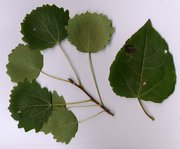Aspen
|
|
| Aspen | ||||||||||||
|---|---|---|---|---|---|---|---|---|---|---|---|---|
 A Quaking Aspen grove | ||||||||||||
| Scientific classification | ||||||||||||
| ||||||||||||
| Species | ||||||||||||
|
Populus adenopoda |
Aspens are trees of the willow family and comprise a section of the poplar genus Populus sect. Populus. There are six species in the section, one of them atypical, and one hybrid:
- Populus tremula - Common or Eurasian Aspen (northern Europe & Asia)
- Populus tremuloides - Quaking or American Aspen (northern & western North America)
- Populus grandidentata - Bigtooth Aspen (eastern North America, south of P. tremuloides)
- Populus adenopoda - Chinese Aspen (China, south of P. tremula)
- Populus sieboldii - Japanese Aspen (Japan)
- Populus alba - White Poplar (northwest Africa, southern Europe, east to central Asia)
- Populus x canescens - Grey Poplar (hybrid P. alba x P. tremula)
The five typical aspens are all native to cold regions with cool summers, in the far north of the Northern Hemisphere, extending south only at high altitudes in mountains. The White Poplar by contrast is native to much warmer regions, with hot, dry summers. They are all medium-sized deciduous trees reaching 15-25 m tall, exceptionally to 30 m.
Aspens (apart from the aberrant White Poplar) are distinguished by their nearly round leaves on mature trees, 4-12 cm diameter with irregular rounded teeth. They are carried on strongly flattened leaf stems, which enable the leaves to twist and flutter in the slightest of breezes. The juvenile leaves on young seedlings and root sprouts differ markedly from the adult leaves, nearly triangular, showing here the typical leaf shape of most other poplars; they are also often much larger, 10-20 cm long. The five typical aspens are distinguished from each other by leaf size and the size and spacing of the teeth on the adult leaves. White Poplar leaves differ in being deeply five-lobed, covered in thick white down, and having only a slightly flattened leaf stem.
All the aspens (including White Poplar) typically grow in large colonies derived from a single seedling, and spreading by means of root suckers; new stems in the colony may appear at up to 30-40 m from the parent tree. Each tree only lives for 40-150 years above ground, but the root system of the colony is long-lived, in some cases for many thousands of years, sending up new trunks as the older trunks die off above ground. Some aspen colonies become very large with time, spreading about a metre per year, eventually covering many hectares. They are able to survive intense forest fires as the roots are below the heat of the fire, with new sprouts growing after the fire is out.
Aspens_autumn_yellow.jpg
Aspens are important food plants for the larvae of Lepidoptera species including Emperor Moth, Figure of Eighty, Clouded Border, The Engrailed, Common White Wave, Common Wave, Poplar Hawk-moth, Poplar Kitten and Coxcomb Prominent.
Cultural aspects
The aspen tree's quivering leaves are, in Christian lore, said to be the result of arrogance at the Crucifixion because the aspen did not tremble like other trees. A German version claims that the aspen was the only tree to refuse to acknowledge Jesus' divinity. The cross that Christ was crucified on is sometimes said to have been aspen wood. As aspens do not occur in Palestine, this legend is most improbable. It is also sometimes said that aspen leaves are made from female tongues, and their quivering is due to women's inability to stop talking.
Basque sheepherders of the 19th and 20th century carved texts and figures on aspens of the American Southwest to express their loneliness.
Aspen as a proper name
Fall_Aspen_Trees_in_the_La_Salle_Mountains.jpg
- Aspen, Colorado is a ski-resort town in the United States of America.
- Aspen, Nova Scotia is a small community in Guysborough County.
- Aspen Hill, Maryland is also a place in the United States of America.
- Aspen Matthews is the heroine of the comic book Fathom.
- Aspen Parkland is a Ecoregion found in three parts of Alberta: Foothills, Central, and Peace River. It is distinguished by the Aspen Trees that give its name.
External links
Aspen Information Resource (http://www.treesforlife.org.uk/tfl.aspen_info_resource.html)de:Espe (Pappel) eo:Tremolo fr:Tremble nl:Ratelpopulier fi:Haapa zh:杨树

